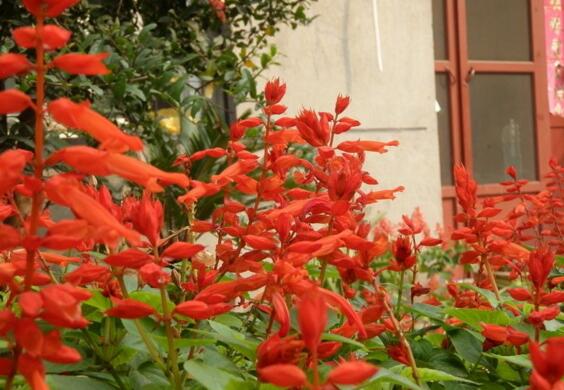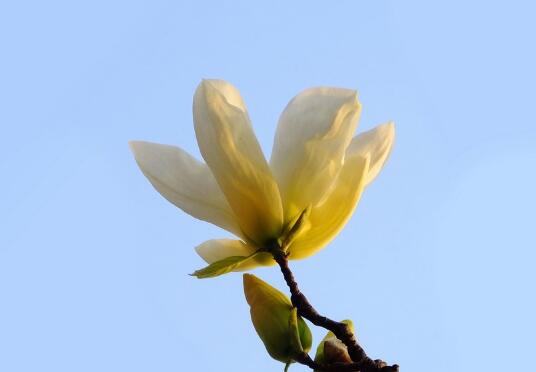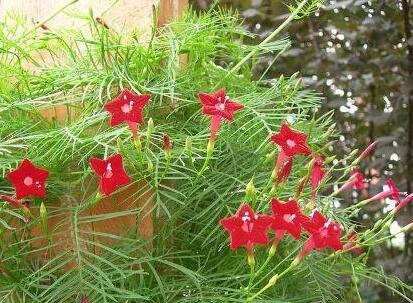How to grow a string of red, a string of red culture methods and precautions / soil is very important
A string of red is cultivated in many places in China because of its strong adaptability and long florescence, and many flower friends will also cultivate it at home in order to play the role of ornamental value in a string of red, but whether it is cultivated in open field or potted, we all need to pay attention to certain skills, so how to grow a string of red? Let's take a look at a string of red breeding methods and points for attention.
How to plant a string of red

Before planting a bunch of red, flower friends should first have a certain understanding of its morphological characteristics and growth habits, only in this way can we take correct maintenance skills according to its characteristics, such as it is afraid of high temperature and flower friends do not cool down in summer, the plant is easy to wither and die, let's take a look at its morphological characteristics and growth habits.
The morphological characteristics of a string of red
A string of red is a sub-shrubby herb, the height of the plant is generally less than 1 meter, the stem is obtusely tetrahedral, the leaves are oval and glabrous on both sides, the inflorescence is in the shape of a wheel umbrella, the bracts are red so that their foreheads are large, and the buds are wrapped in bracts. Flowering is colorful, beautiful and very good-looking.
The growth habit of a string of red
Before figuring out how to grow a string of red, its growth habits must be familiar with, because it is related to the development of daily maintenance skills. In terms of growth habits, a string of red Xiyang can also grow in a semi-shady environment, like fertile, loose soil, like slightly acidic soil afraid of alkalinity matrix, cold and heat tolerance are very general, so avoid frost and snow and high temperature when breeding.
The breeding method and matters needing attention of a string of red
1. Soil
With regard to the soil, the requirements of a string of red are fertile, loose, well drained, and must be slightly acidic. The best PH value is between 5.5 and 6.0. If the alkaline soil is extremely disadvantageous to its growth, it will cause the plant to wither and die. Therefore, it is commonly used to mix rotten leaf soil and fine sand.
2. Temperature
The most suitable temperature for the growth of a string of red is 20-25 degrees, which is more afraid of high temperature and cold, so the temperature should be kept at 15-30 degrees. If the leaves are below 15 degrees, the leaves are easy to turn yellow and fall off, while when they are higher than 30 degrees, the leaves and flowers will be small and thin.
3. Lighting
The intensity of light is often closely related to the temperature, for example, the temperature in the sun is generally higher than indoors, so when planting a string of red, it is best to put it in a bright place where scattered light can be seen. If it is spring and autumn can also give it appropriate sunlight, summer can not be managed in the sun.
4. Moisture
Flower friends who have raised a string of red flowers often have a headache in watering, but watering actually has certain skills, so how to plant a string of red in watering? You can water the soil flexibly according to the wetness of the soil, rather than watering it all the year round. The specific technique is to water the soil immediately when it is found to be white, to make sure it is thoroughly watered, and then to let it grow normally.
5. Fertilization
A bunch of red fertilizer, so when planting, you can add some base fertilizer to the soil, and you can apply liquid fertilizer once every 10-15 days when you are growing vigorously, which can make the leaves and flowers brighter. Fertilization is usually carried out in the morning or sunny days.
Matters needing attention
⑴, topping: in the process of growth, we need to top a bunch of red many times, in which the topping during the seedling is very important, it can control the plant growth height and promote the germination of lateral branches, the method is to remove the top buds.
⑵, the right amount of fertilizer and water: watering and fertilization are very important for a string of red, but we must pay attention not to excessive fertilizer and water, because a string of red is a plant that is afraid of stagnant water, and if it is watered too much, it is easy to let the fragile roots rot, thus making the plant wither and grow badly.
⑶, pest control: a string of red will also be attacked by diseases and insect pests, such as red spiders and aphids do great harm to it. The way to prevent it is to strengthen maintenance and management, while prevention and control requires spraying 1500 times of omethoate solution.
Pot culture methods and matters needing attention of a string of red plants
Control light and temperature
After planting a bunch of red, put it in a cool place for 3 days to slow down the seedlings. Then put it in the sun to ensure sufficient light. To facilitate the control of light intensity, a suggested scaffolding can be built above the flowerpot. Shade 50% when the light is too strong, especially at noon in summer. Once at a low temperature, it is necessary to put on a plastic film for proper heat preservation, which can usually be done at night or on rainy days.
Maintain moisture and humidity
A string of red likes a humid environment and should be sprayed with water once a day, except on rainy days. When watering, the difference between ground temperature and water temperature should not exceed 5 ℃. When the temperature is high, water is often sprayed to the surrounding environment to lower the temperature and increase the humidity of the air. Clean the branches and leaves regularly to improve photosynthesis, once every 15-20 days.
Give priority to extra-root topdressing
Soil provides an important guarantee for the growth and development of flowers, but does not guarantee the healthy growth of plants. It is far from enough to rely on a little water, fertilizer and air in the soil. The specific methods are as follows:
After potted for a week, fertilize outside the root once. Spray once a day for the next three days. The fertilizer was mixed with urea plus potassium dihydrogen phosphate and a small amount of calcium superphosphate. The spraying time is in the early morning and evening.
After that, watering was combined with fertilization, and extra-root fertilization was carried out 8-12 hours after watering. Note that it can be applied around in windy days or in strong light.
Control the date of flowering
When sowing in different seasons, the flowering time is also different. Sow in spring and blossom in autumn; sow in greenhouse in autumn and blossom from April to May the following year. The florescence can be controlled in the following ways during flowering:
Cutting off the branches of the buds in time can postpone the flowering period appropriately.
After each flower failure, pick off the residual flowers in time, strengthen the water and fertilizer management, a string of red can re-branch and blossom, prolong the flowering period.
Timely pruning and topping
Potted plants need to top 3 times after transplanting to inhibit their growth and promote the germination of lateral buds. The plants grown in this way are short and strong, and there are more flower heads.
How to grow a string of red? how to cultivate a string of red?
A string of red is our common flowers and plants, generally in flower beds, roadsides, courtyards and other places are more common, home can also see a string of red, but less, in fact, a string of red is more suitable for home layout and use of a kind of flower plants, because its breeding method is relatively simple, let's take a look at a string of red how to grow it!
A string of red life habits
A string of red Xiyang is also resistant to semi-overcast, while a string of red requires loose, fertile and well-drained sandy loam, but it is very sensitive to the treatment of soil with methyl bromide and alkaline soil, so it is suitable for growth in pH5.5~6.0 soil. The cold resistance is poor, and the suitable temperature for growth is 20-25 degrees Celsius. Stop growing below 15 degrees Celsius, and the leaves are withered and yellow and fall off below 10 degrees Celsius.
The planting effect of a string of red
1. Layout environment: a bunch of red inflorescences are plump. The flower color is scarlet, the flower quantity is large, appears to be more festive, is mostly used for the environmental decoration of important festivals, can decorate flower beds, flower borders or flower beds alone, and can also be used as the edge of flowers and flower groups. Potted a string of red is an indispensable material for setting up potted flowers, which can form a sharp color contrast with other potted flowers.
2, decorate the home: a string of red dwarf varieties can be planted in pots, used for home windowsill, balcony beautification and house side, front steps embellishment, delicate color, warm atmosphere. Another string of red there are many varieties, colors are also rich, pink and white, red and white and blue-white, purple-white and other colors to join, so that the living environment is more elegant and chic.
The breeding method of a string of red
1. Cutting propagation: the propagation of a bunch of saffron by cutting can be carried out from May to August in summer and autumn, and the cuttings take the tender branches with abundant tissue, remove the terminal buds and then plant them, which is easy to take root. In the summer high temperature and dry season, pay attention to shade cooling, often spray water, keep moist, about 15 days can be transplanted, is a relatively fast and relatively simple string of red breeding method.
2. Sowing and reproduction: in the south, it is usually the best time to sow seeds in a string of red open fields from late March to early April. The sandy soil with good drainage conditions and leeward is selected as the seedbed, the border surface is loosened, broken and leveled, and it is exposed to the sun for a few days. Then disinfect the seedling soil with potassium permanganate solution. Sow a bunch of red seeds on the seedbed, and then sprinkle the appropriate amount of carbofuran on the seedbed. Usually keep the seedbed moist, seedlings can emerge in 6-7 days under the condition of 16-21 ℃, and potted seedlings can be transplanted when 3-4 true leaves.
The culture method of a string of red
1. Sunshine: a string of red is a light-loving flower, and the cultivation site must have sufficient light, which is very beneficial to the growth and development of a string of red. If the light is not enough, the plant is easy to grow, the stem and leaf is slender, the leaf color is light green, if the light is poor for a long time, the leaf becomes yellow and falls off. If flowering plants are placed in places with poor light, the flowers are often not bright and easy to fall off. Sensitive to photoperiod, short-day light promotes the blooming of a bunch of safflower.
2. Temperature: a bunch of saffron is sensitive to temperature. Seeds germinate at 21-23 degrees, it is difficult to germinate below 15 ℃, and irregular below 20 ℃. 7: 13 ℃ is suitable for seedling stage in winter, and 13: 18 is the best in March-June growth period. When the temperature exceeds 30 ℃, the growth and development of the plant is hindered, and the flowers and leaves become smaller. Therefore, the summer high temperature period needs cooling or proper shading to control the normal growth of a string of red. It is easy to suffer frost injury under low temperature of 5 ℃ for a long time.
3. Pruning: the heart should be picked immediately after a string of red is planted, and at least twice during the growing period, so that the plant is short and strong, the flower branches are many and the flowers are dense.
4. Insect pests: if a string of red plants are prone to rot if they are planted with high temperature, high humidity or insufficient light, attention must be paid to adjusting the temperature to make the air circulate. In addition, a string of red is prone to red spiders, aphids and other insect pests, which can be controlled by spraying dimethoate emulsion 1500 times.
5. Fertilization: a string of red is relatively simple on fertilizer, generally speaking, as long as the basic fertilization is carried out on the planted soil.
- Prev

How to plant magnolia in pot, culture methods and precautions / sufficient light of magnolia
Magnolia is a unique plant in China, which is highly ornamental. However, if you want to raise it well, you need to pay attention to a lot of things. About how magnolia is potted? What are the breeding methods and matters needing attention of magnolia? Next, the editor will take you to learn about it. First, how to plant magnolia in pots
- Next

What about the yellowing of pineapple leaves? 7 common reasons need to know / attach solutions.
In the process of planting a plant, there are many factors that affect its growth, such as the leaves may turn yellow when we are not watered properly, the roots may rot when there is stagnant water for a long time, and so on. Therefore, we need to use the correct method of planting pineapple to avoid this situation.
Related
- Fuxing push coffee new agricultural production and marketing class: lack of small-scale processing plants
- Jujube rice field leisure farm deep ploughing Yilan for five years to create a space for organic food and play
- Nongyu Farm-A trial of organic papaya for brave women with advanced technology
- Four points for attention in the prevention and control of diseases and insect pests of edible fungi
- How to add nutrient solution to Edible Fungi
- Is there any good way to control edible fungus mites?
- Open Inoculation Technology of Edible Fungi
- Is there any clever way to use fertilizer for edible fungus in winter?
- What agents are used to kill the pathogens of edible fungi in the mushroom shed?
- Rapid drying of Edible Fungi

